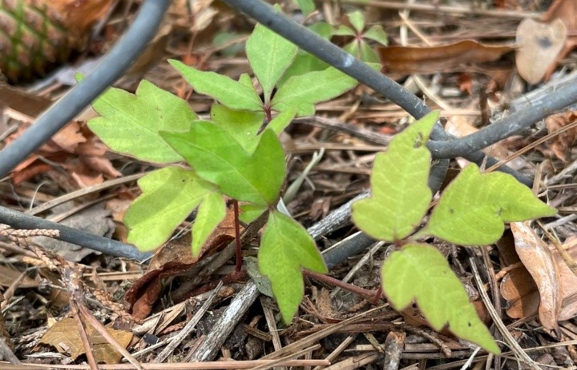
by Pat Williams | Jul 1, 2021
We work very hard to maintain our gardens and then we look up and vines are growing 20′ into the trees. I get asked frequently “what is growing up my trees?” My first answer is “probably the same things growing on your fences.” These include Smilax species, commonly called catbrier or greenbrier, Vitis rotundifolia, referred to as wild muscadine grape, Parthenocissus quinquefolia or Virginia Creeper, and the one to be most careful with, Toxicodendron radicans, known by many as Poison Ivy.
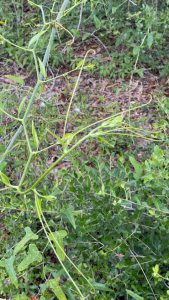
Spring growth on the Smilax vine.
Smilax is a native vine that grows quickly in spring and all summer. There are 12 species in Florida and 9 species commonly found in the Panhandle. Besides being armed with thorns on their stems and some leaves, Smilax spreads by underground stems called rhizomes. If you choose to ignore it, some species can cover your trees and the stems become woody and hard to remove. This vine also produces fruit and seeds are dispersed by birds all while the underground rhizomes are spreading under your lawns and gardens.
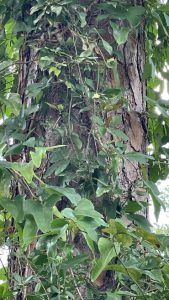
Smilax can quickly cover a tree trunk.
Removal can be difficult and mowing the vines only encourages more growth. When trying to remove by hand, wear heavy leather gloves and some eye protection because of the thorns. Cut the stems about three feet above the ground which allows you some stem to pull on to bring it out of your tree. You also then have a handle to pull and try to remove some of the rhizome from underground. Digging rhizomes is time consuming, but gives you piece of mind that they won’t come back immediately. Our family actually harvests the new shoots in spring and we use them like asparagus.
Wild muscadine grape is also native and difficult to remove. Most of the vines in nature are male and only produce by runners along the ground and then grow upwards. The female vine can produce 4-10 grapes in a cluster and then reseeds itself.
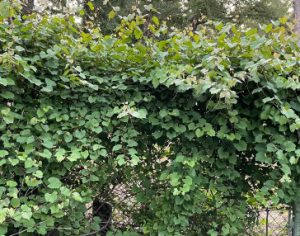
Wild muscadine grape covering a fence.
Wild grape completely covers plants and eventually the plants underneath can die. There are no thorns to contend with when removing wild grape, it is just time consuming, especially if it has taken over your fence or natural areas.
Virginia Creeper is a native vine, still considered a nursery plant in some areas of the country, and has bright red fall color.
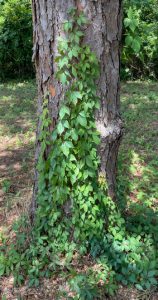
Virginia Creeper climbing a tree trunk.
It is most often confused with poison ivy because of having five leaflets per leaf whereas poison ivy only has three leaflets per leaf. It spreads by seeds, runs along the ground, and is the easiest of these four vines to remove from your property.
Poison Ivy is a native vine distinguished by its three leaflets with the individual leaflets getting up to 6″ long. This vine spreads by seeds and underground rhizomes. What makes removal of this vine difficult is the urushiol oils which causes the skin rashes and blistering.
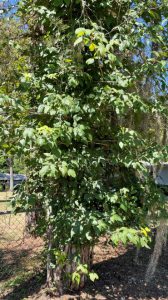
Poison ivy covering a tree trunk.
Care must be taken to cover up all skin and I recommend wearing waterproof clothes versus cotton which can absorb the oils and transfer them to your skin. Under no circumstances should these vines be put on the burn pile, the oils can become airborne and then you can inhale them.
Here are a few helpful tips when battling these native vines. First have patience and be dedicated, this removal will not happen over night. It may take a year or two to rid your property of the original vines. Be diligent though, because birds will continually land in your trees and deposit more seeds to get a fresh start. Try to remove vines when they are young and just beginning to climb your trees and fences. If you know you don’t have the time or energy to remove the vines from all your trees, at least cut the vines close to the ground to reduce flowering and new seeds. Be careful with poison ivy because falling leaves still contain oils. Once the vines start to have a new flush of growth, spray a non-selective herbicide on new growth and you should have good results. Lastly, remember one person can make a difference in trying to reduce the number of nuisance vines in our communities.
Here are some sited references to help with your removal tasks. Key to Nine Common Smilax Species of Florida. https://edis.ifas.ufl.edu/publication/fr375. Smilax is a Vine that can be Difficult to Control. http://blogs.ifas.ufl.edu/wakullaco/2017/04/21/smilax-is-a-vine-that-can-be-difficult-to-control/. The Muscadine Grape (Vitus rotundifolia Michx.) https://edis.ifas.ufl.edu/publication/hs100. Muscadine Grape Vines: Difficult to Control in Your Landscape. http://blogs.ifas.ufl.edu/wakullaco/2017/03/24/muscadine-grape-vines-difficult-to-control-in-your-landscape/. Parthenocissus quinquefolia: Virginia Creeper https://edis.ifas.ufl.edu/publication/fp454. Identification of Poison Ivy, Poison Oak, Poison Sumac, and Poisonwood. https://edis.ifas.ufl.edu/publication/EP220.
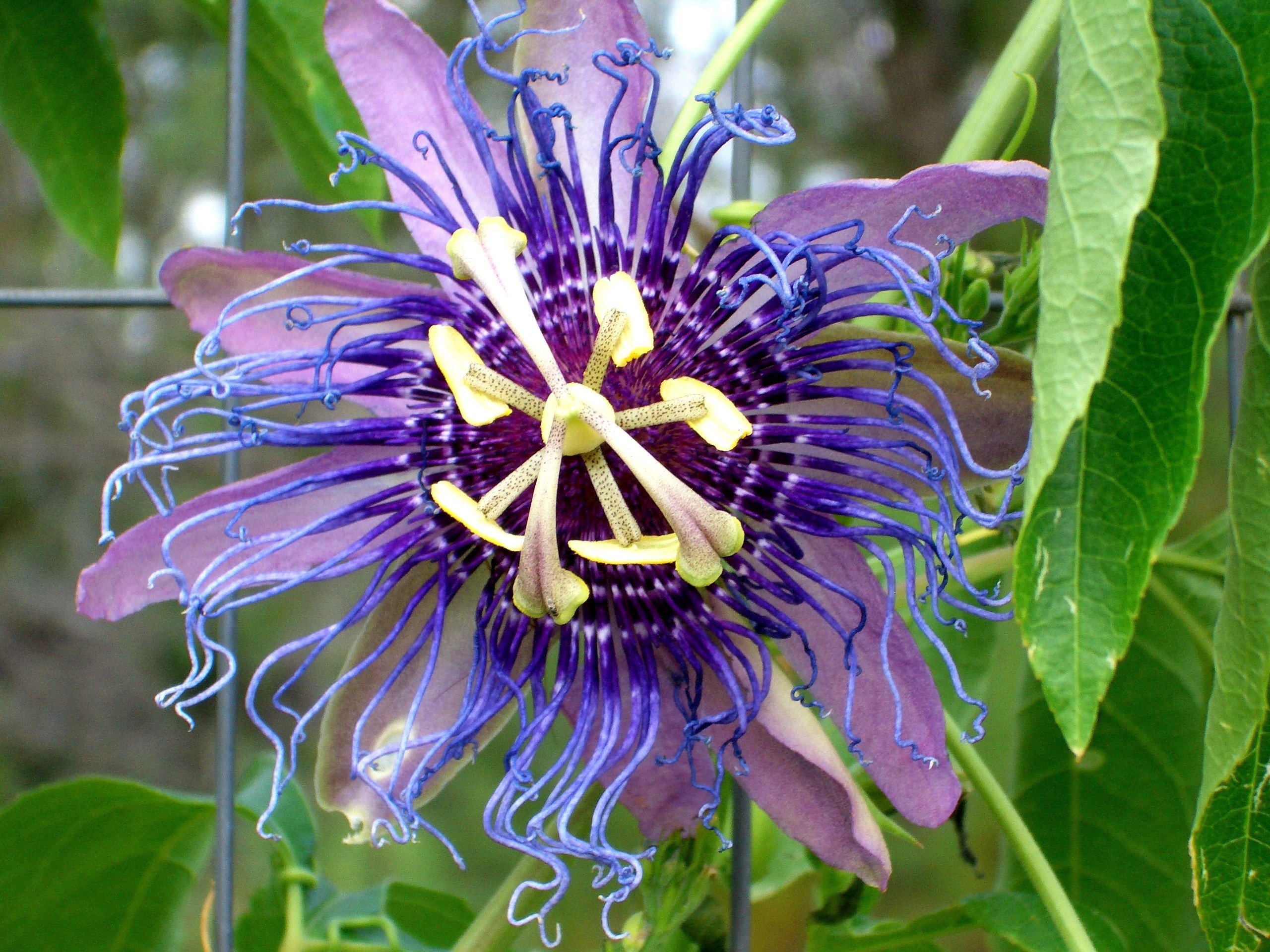
by Carrie Stevenson | Aug 11, 2017
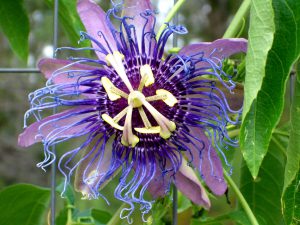
The passionflower vine is beautiful and attracts butterflies, but can also be used for food and sedation drugs. Photo credit: Dorothy Birch
Ethnobotany lies at the intersection of culture, medicine, and mythology. The “witch doctors” and voodoo practitioners, the followers of the Afro-Cuban religion of Santeria, and the wise elders of ancient Chinese civilizations are all ethnobotanists. So, too, are the modern day field biologists who discover and develop medicinal plants into an estimated half of our pharmaceutical drugs. Simply put, ethnobotany is the study of how people and cultures (ethno) interact with plants (botany).
For tens of thousands of years, humans have been learning about plants’ chemical, nutritious, and even poisonous properties. Plants evolve these properties to defend themselves against pathogens, fungi, animals and other plants. Other properties, like color, scent, or sugar content may attract beneficial species. Humans most likely started paying attention to plant characteristics to decide whether to eat them. From there, one can imagine people started using plants to build structures or use fiber for ropes, baskets, and clothing.
My first experience with the idea of ethnobotany was as a college student on a study tour of Belize. A professional ethnobotanist took us on a tour of the Maya Rainforest Medicine Trail, pointing out dozens of native trees, shrubs, and grasses used for medicinal and cultural purposes by local tribes. From birth control and pain relief to chewing gum and pesticides, the forest provided nearly everything Central American civilizations needed to survive for thousands of years and into the present. The tour captured my imagination as I considered the possibilities yet undiscovered in the deep rainforests worldwide.
Of course, there is no need to travel out of the country, or even the state, to learn about useful native plants. One of my favorite publications put out by UF IFAS Extension specialists is “50 Common Native Plants Important in Florida’s Ethnobotanical History.” Another fascinating source of information about historic, cultural, and even murderous uses of plants is Amy Stewart’s Wicked Plants: The Weed That Killed Lincoln’s Mother and Other Botanical Atrocities. Plants with interesting historical uses make for great stories along a trail, and help create a connection between the casual observer and the natural world around them.
A handful of interesting native plants with significant medicinal properties include the cancer-fighting plants saw palmetto (Serenoa repens) and mayapple (Podophyllum peltatum). Saw palmetto berries are used for prostate cancer treatment, while the $350+ million annual Florida mayapple harvest helps produce chemotherapy drugs for several types of cancer. The carnivorous bog plant, pink sundew (Drosera capaillaris) uses enzymes to break down insect protein, and Native American tribes used the plant for bacterial and fungal skin disorders.
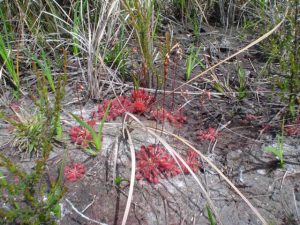
Sundews, tiny carnivorous plants found in pitcher plant bogs, use an enzyme to dissolve insect proteins. Native Americans recognized this property and used the plant for skin maladies. Photo credit: Carrie Stevenson, UF IFAS Extension
Many plants had (and still have) multiple uses. Yaupon holly (Ilex vomitoria) leaves brewed as a highly caffeinated tea were used ceremonially and before warfare by many southeastern American Indian tribes, and then later by early American settlers when tea was difficult to import. Holly branches were used for arrows, and the bark for warding off nightmares. The purple passionflower, or maypop (Passiflora incarnata) vine attracts butterflies and produces a pulp used for syrups, jams, and drinks. Passionflower extract has also been developed into dozens of drugs and supplements for sedation.
Early civilizations living closer to the land knew many secrets that modern medicine has yet to unlock. Thanks to the ethnobotanists, the field and forest will continue to heal and provide for us for many generations yet to come.
CAUTION: Many of the plants listed or referenced can have hazardous or poisonous properties without appropriate preparation or dosage. Allergic reactions and prescribed drug interactions may occur, and many unproven rumors exist about medicinal uses of plants. Always consult a physician or health professional before trying supplements.
by Beth Bolles | Dec 4, 2015
A visit to a nursery and homeowners will see so many new selections of plants for the landscape. Some of these plants are new plant developments and may include plants we could not previously grow in Florida’s heat and humidity. One new plant series is the Southgate® Rhododendrons.
Anyone from more northern areas of the South is very familiar with the rhododendrons that offer showy spring blooms. Those particular rhododendrons just don’t make it in our Florida climate.
The Southgate® series from Louisiana were developed to be more tolerant of our weather conditions. Homeowners must still consider plant placement very carefully since these plants have some specific requirements even in Florida. Plants will do best in shade or filtered shade, especially in the afternoon. They do like an acid soil amended with compost and areas that are well drained. Homeowners will need to supply water during the growing season to maintain a uniform soil moisture.
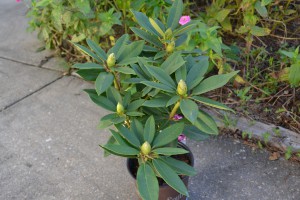
Rhododendron foliage with buds.
Consider trying one of these newer rhodendrons if your landscape has a suitable spot and you will definitely enjoy a bright spot of color come spring.
Special Note: If you have animals or children be cautious since all plant parts are toxic if ingested.
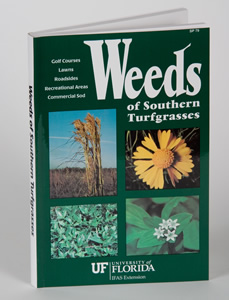
by Taylor Vandiver | Aug 3, 2015
As our world and our lives become more centered on technology it seems that all the information we need is just a touch screen away. After all, you are most likely reading this article from a laptop, smart phone, or tablet. While convenient and portable, there are some places you might not wish to take your electronics and one of those places is in the garden. You may say, “Well Taylor, that’s what they make waterproof, shatterproof, dirt proof, etc. cases for!” and I would say that you’re right. However, technology has many limiting factors such as battery life and screen glare. Now believe me, I am by no means disparaging technology! I come from a generation that considers Wi-Fi as necessary as water and an outlet comparable to oxygen. But there is something to be said for having a book in hand when out in the garden. For one thing your neighbors won’t worry about you as they see you march around the garden with your phone in the air doing the “No Signal Dance”. Also, a book is great to have in order for you to jot down any notes or reflections. I would like to list for you a few books that I often reference when I receive calls from homeowners. These books will cover various topics and all of them can be found on the UF/IFAS Bookstore website, the links for each can be found below. If you have any questions contact your local Extension Office and, as always, feel free to contact me and I can give you a rundown on my collection of favorite reference books!
- New to the UF/IFAS bookstore: “Trees: North & Central Florida” a field guide to 140 common tree species. This sturdy, pocket-sized field guide–the only one of its kind for north and central Florida–is designed for landscape professionals, arborists, naturalists, gardeners, and anyone seeking to know the trees around them. Full color photographs of leaves, bark, flowers and full trees, together with clear descriptions and other information make identifying trees easier than ever. This book also features a handy diagnostic key, an introduction to plant parts, a glossary and a ruler to guide you, whether you’re a trained botanist or a complete beginner.
- “Poisonous Plants of the Southern United States” John W. Everest, Thomas A. Powe, Jr., and John D. Freeman (of Auburn University). Identification of common poisonous plants found along fence lines and in pastures in the Southern United States.
- “Weeds of Southern Turfgrasses” This practical weed identification guide contains 427 color photographs of 193 weed species, their geographical range, and life cycle descriptions. Includes a glossary of taxonomic terms and index of common and scientific names.

- “Disorders and Diseases of Ornamental Palms” Recently revised and updated, this ID deck is a diagnostic tool for landscape professionals and backyard hobbyists. The color photographs and explanatory text helps users identify and distinguish between the nutritional deficiencies, physiological disorders and common diseases of ornamental palms. All palms in the U.S. suffer from disorders and diseases, and identifying the differences can be tricky. These cards feature photographs and descriptions and are cross-referenced for easy comparison between different symptoms and the potential problems causing them. Includes a table of contents and 55 laminated, ring-bound cards.
- “Florida Lawn Handbook: Best Management Practices for Your Home Lawn in Florida” Written in practical language by turfgrass experts, this highly-anticipated new edition offers the most current lawn management information. Color plates identify various grass types, weeds, diseases, and insects—including those that are good for your lawn! Chapters cover selection, establishment, and maintenance for each type of lawn; soil analysis and fertilization; yearly calendars for lawn care and culture; mowing, watering, and calibrating sprinkler systems and fertilizer spreaders; overseeding for winter color; preparing a lawn for drought and low temperatures; safe pesticide application and use; the latest integrated pest management strategies; organic lawn care; and complete, illustrated diagnostic information for weeds, diseases, insect problems, nematodes, and other pests.
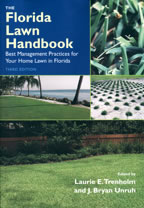
- “Sustainable Gardening for Florida” Gardeners today face a unique challenge: how do you create a beautiful, thriving landscape without over-use of fertilizers, pesticides, and water? Sustainable Gardening for Florida might be the first place to look for answers. This book provides interesting, money-saving ideas to reduce your ecological footprint. It includes chapters on composting and mulching, integrated pest management, water-wise irrigation and rainwater harvesting, preparing your garden for disasters, and all aspects of managing meadows, lawns, trees and shrubs, edible gardens, rain gardens and waterfront gardening.
- “Vegetable Gardening in Florida” From James Stephens, the founder of the Florida Master Gardener Program, this is the one resource you need to successfully grow vegetables in Florida. Whether you’re growing beans, tomatoes, herbs, or any other Florida crop, this guide will take you from site selection and insect management through the harvest and storage of your produce. Useful planting guides, gardening measurement conversions, and organic gardening information are accented with full-color throughout.
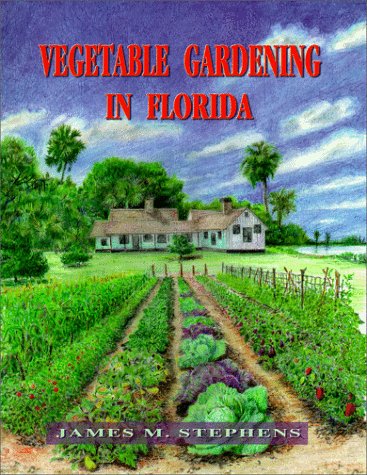
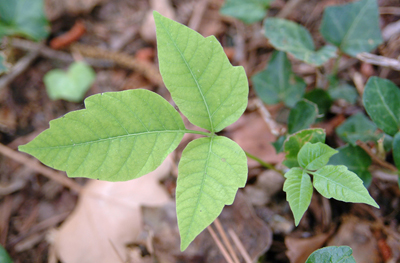
by Taylor Vandiver | Jun 15, 2015
As summer comes to its apex you may find yourself longing to move your activities outdoors and commune with nature. However, as you are reveling in the warm weather while hiking, camping, biking, gardening, etc. remember that there are native plants of a less friendly nature hiding in plain sight. I’m sure you have all heard the tried and true mantra “Leaves/leaflets of three, let it be”, we suggest you hum that to yourself as you head outdoors in order to save yourself from the consequences of an accidental poison ivy encounter.
While I am not a native of Florida, I grew up in the Deep South and I have had many dealings with our aforementioned foe. Poison ivy (Toxicodendron radicans) is a native to North America which contains an oil known as urushiol. This oil can cause a severe skin rash (dermatitis) when any part of the plant is contacted. The reaction and rash, in susceptible humans, usually starts with itchiness and swelling, followed by the reddish inflammation of tiny pimples or formation of blisters at the areas of contact. The rash can begin as early as an hour after contact or up to five days after contact. All parts of poison ivy, including the hairy-looking aerial roots, contain urushiol at all times of the year, even when bare of leaves and fruit in winter. An allergic reaction can occur by touching the plant directly or indirectly contacting it through animals, tools, clothing, shoes and other items. Also, be aware when preparing your campfires and bonfires that the smoke from burning poison ivy contains oil particles that can be inhaled and cause lung irritation.

A picture of poison ivy with its characteristic 3 leaflets.
Now that you know the consequences of coming in to contact with poison ivy, let’s talk about where you can find it and how it can be identified. Poison ivy can grow in shady or sunny locations throughout Florida. It’s habit can be a woody shrub up to 6 feet tall or a vine up to 150 feet tall that climbs high on trees, walls and fences or trails along the ground. Leaves emerge with a shiny reddish tinge in the spring and turn a dull green as they age, eventually turning shades of red or purple in the fall before dropping.
Poison ivy has little or no effect on animals, but, as we discussed, they may carry the irritating substance on their hair and thereby transmit it to us more susceptible humans. Not only are the berries attractive to birds, but the leaves and fruit are also an important food source for deer.
Poison ivy is often confused with another native, the Virginia creeper (Parthenocissus quinquefolia). However, this trailing or climbing vine can be distinguished from poison ivy rather easily by its five divided leaflets. Also, Virginia creeper has blue-black berries and tendrils that end in tiny sticky pads that attach to trees and other surfaces.
So, what methods of treatment are available to those who suffer the wrath of poison ivy? If you suspect that you have come into contact with poison ivy always wash your skin with strong soap and cold water immediately! If you scrub with hot water you will open up your pores and let the oil into your skin, causing further irritation. Remove and wash all clothes, including shoes and socks in a strong detergent and warm or hot water. Keep your hands away from eyes, mouth and face. Don’t scratch the rash! To soothe the itch apply calamine lotion, zinc oxide or other doctor recommended products. Always call and visit your doctor if these measures don’t work, you know you are highly allergic or the rash persists.
So, how can you stop poison ivy at the source and avoid these painful symptoms? The first approach would be to eradicate an area by hand removal. Anyone who is extremely sensitive to the oil should ask for help when removing these plants. Always wear proper clothing that covers all areas that could potentially come in to contact with the plant. Also, lotions and creams containing the active ingredient bentoquatam can be used before the weed whacking begins. A suggested technique for removal using chemicals is to cut out a section of actively growing vine and promptly applying a legal herbicide to the bottom half of the cut stem to control re-sprouting. Choose a herbicide only after reading the pesticide label. Some products are labeled for specific sites, and pesticide registrations change over time. Please check with your UF/IFAS Extension service for current recommendations. Hopefully, this article will help you take preventative and proper measures against poison ivy and give you a more care free and informed attitude when partaking in summer activities!
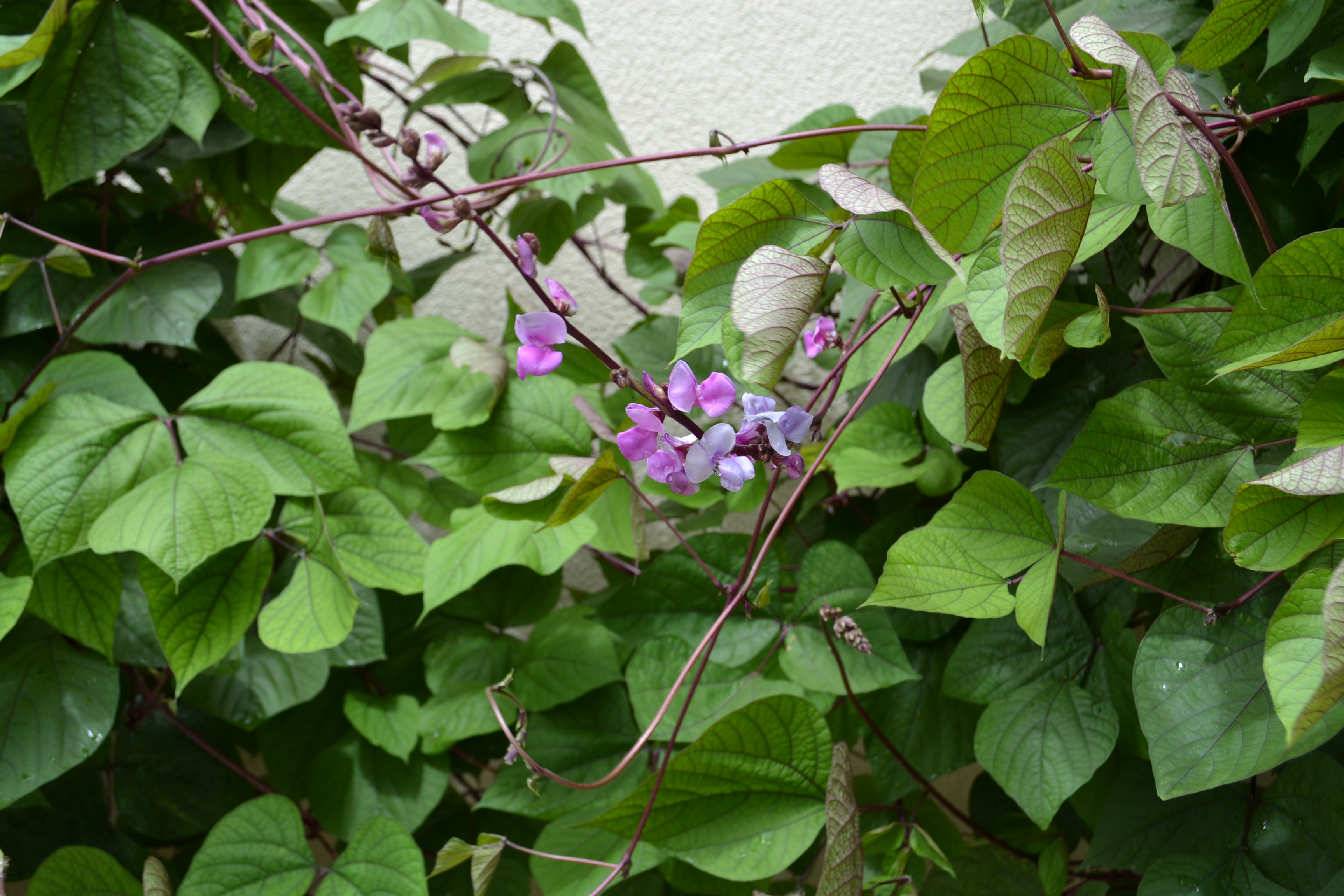
by Beth Bolles | May 6, 2015
Everyone is interested in growing an easy plant that offers interest all throughout the warm season. Look no further than an old favorite, the purple hyacinth bean, Lablab purpurea.
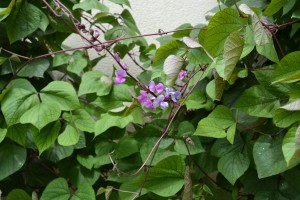
Purple flowers are held above foliage.
An warm season annual vine that grows easily from seeds plants directly in the ground or started in small pots, purple hyacinth bean will quickly cover a trellis, fence, or other sturdy support that you provide. One of the features will be beautiful purple flowers that form on purple stems during the summer. Purple pods will form after the flowers fade and persist until a frost. Mature seeds can be collected and saved for planting the following spring. Seeds that fall to the ground are likely to sprout on their own when soils warm again the following year.
Even though purple hyacinth bean is an edible plant in many parts of the world, it is mostly considered an ornamental in our area. One of the reasons is that raw beans are poisonous and must be properly cooked before eaten. Because of the toxicity of the beans, it is best to plant in the ornamental garden rather than the edible garden.
Additional features of this easy vine are that it is low maintenance, requiring little fertilization and it attracts bees and butterflies. Install seeds or transplants in well drained soil in full sun and you are ensured a plant that will attract attention.
















